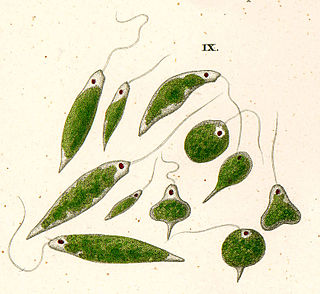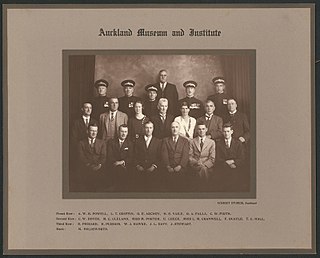
A flight simulator is a device that artificially re-creates aircraft flight and the environment in which it flies, for pilot training, design, or other purposes. It includes replicating the equations that govern how aircraft fly, how they react to applications of flight controls, the effects of other aircraft systems, and how the aircraft reacts to external factors such as air density, turbulence, wind shear, cloud, precipitation, etc. Flight simulation is used for a variety of reasons, including flight training, the design and development of the aircraft itself, and research into aircraft characteristics and control handling qualities.

Euglenids or euglenoids are one of the best-known groups of eukaryotic flagellates: single-celled organisms with flagella, or whip-like tails. They are classified in the phylum Euglenophyta, class Euglenida or Euglenoidea. Euglenids are commonly found in fresh water, especially when it is rich in organic materials, but they have a few marine and endosymbiotic members. Many euglenids feed by phagocytosis, or strictly by diffusion. A monophyletic subgroup known as Euglenophyceae have chloroplasts and produce their own food through photosynthesis. This group contains the carbohydrate paramylon.

The Great Attractor is a region of gravitational attraction in intergalactic space and the apparent central gravitational point of the Laniakea Supercluster of galaxies that includes the Milky Way galaxy, as well as about 100,000 other galaxies.

The Physiological Society, founded in 1876, is an international learned society for physiologists with headquarters in the United Kingdom and Ireland.

Arthur William Baden Powell was a New Zealand malacologist, naturalist and palaeontologist, a major influence in the study and classification of New Zealand molluscs through much of the 20th century. He was known to his friends and family by his third name, "Baden".
Mark Wayne Chase is a US-born British botanist. He is noted for work in plant classification and evolution, and one of the instigators of the Angiosperm Phylogeny Group-classification for flowering plants which is partly based on DNA studies. In particular he has researched orchids, and currently investigates ploidy and hybridization in Nicotiana.
Karyorelictea is a class of ciliates in the subphylum Postciliodesmatophora. Most species are members of the microbenthos community, that is, microscopic organisms found in the marine interstitial habitat, though one genus, Loxodes, is found in freshwater.
The Ellis R. Lippincott Award is awarded annually to recognize "an individual who has made significant contributions to vibrational spectroscopy as judged by his or her influence on other scientists." It was jointly established in 1975 by The Optical Society, The Coblentz Society, and The Society for Applied Spectroscopy. The award honors Ellis R. Lippincott, a vibrational spectroscopist who worked at the University of Maryland. Lippincott was one of the developers of the Diamond anvil cell, which is used in high pressure research.
Anthony Russell Bean is an Australian botanist who works at the Queensland Herbarium and Brisbane Botanic Gardens, Mount Coot-tha. Since 1982, he has led the Eucalyptus Study Group of the Society for Growing Australian Plants.

Perkinsids are single-celled protists that live as intracellular parasites of a variety of other organisms. They are classified as the class Perkinsea within the monotypic phylum Perkinsozoa. It is part of the eukaryotic supergroup Alveolata, along with dinoflagellates, their closest relatives, and another parasitic group known as Apicomplexa. Perkinsids are found in aquatic environments, as parasites of dinoflagellates and various animals.

Wikidata is a collaboratively edited multilingual knowledge graph hosted by the Wikimedia Foundation. It is a common source of open data that Wikimedia projects such as Wikipedia, and anyone else, is able to use under the CC0 public domain license. Wikidata is a wiki powered by the software MediaWiki, including its extension for semi-structured data, the Wikibase. As of mid-2024, Wikidata had 1.57 billion item statements.
The Tilden Prize is an award that is made by the Royal Society of Chemistry for advances in chemistry. The award was established in 1939 and commemorates Sir William A. Tilden, a prominent British chemist. The prize runs annually with up to three prizes available. Winners receive £5000, a medal and certificate.

Yoshinori Ohsumi is a Japanese cell biologist specializing in autophagy, the process that cells use to destroy and recycle cellular components. Ohsumi is a professor at Tokyo Institute of Technology's Institute of Innovative Research. He received the Kyoto Prize for Basic Sciences in 2012, the 2016 Nobel Prize in Physiology or Medicine, and the 2017 Breakthrough Prize in Life Sciences for his discoveries of mechanisms for autophagy.

Wilma M. Blom is a marine scientist. Since 2011 she has been Curator, Marine Invertebrates at Auckland War Memorial Museum.

Michael Douglas Crisp is an emeritus professor in the Research School of Biology at the Australian National University located in Canberra. In 1976, he gained a PhD from the University of Adelaide, studying long-term vegetation changes in arid zones of South Australia. In 2020, Crisp moved to Brisbane, where he has an honorary position at the University of Queensland. Together with colleagues, he revised various pea-flowered legume genera.
Paul Irwin Forster is an Australian botanist. He obtained his doctorate from the University of Queensland in 2004 with his thesis The pursuit of plants : studies on the systematics, ecology and chemistry of the vascular flora of Australia and related regions.

The Sinan Pasha Mosque is a mosque in the Bulaq district in Cairo. It was established by the governor of Cairo Koca Sinan Pasha around 1571.

Katalin "Kati" Karikó is a Hungarian-American biochemist who specializes in ribonucleic acid (RNA)-mediated mechanisms, particularly in vitro-transcribed messenger RNA (mRNA) for protein replacement therapy. Karikó laid the scientific groundwork for mRNA vaccines, overcoming major obstacles and skepticism in the scientific community. Karikó received the Nobel Prize in Physiology or Medicine in 2023 for her work, along with American immunologist Drew Weissman.
Wave is a genre of bass music and a visual art style that emerged in the early 2010s in online communities. It is characterized by atmospheric melodies and harmonies, melodic and heavy bass such as reese, modern trap drums, chopped vocal samples processed with reverb and delay, and arpeggiators. Visually, it incorporates computer-generated imagery and animation, and imagery from video games and cartoons.
Erik Bertelsen was a Danish ichthyologist, who specialised in deep sea fish. The fish, Diaphus bertelseniNafpaktitis, 1966 is named in his honour.












